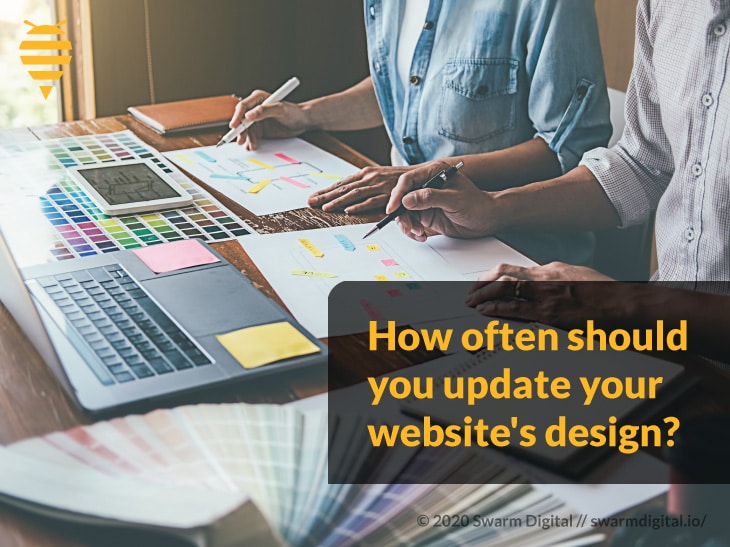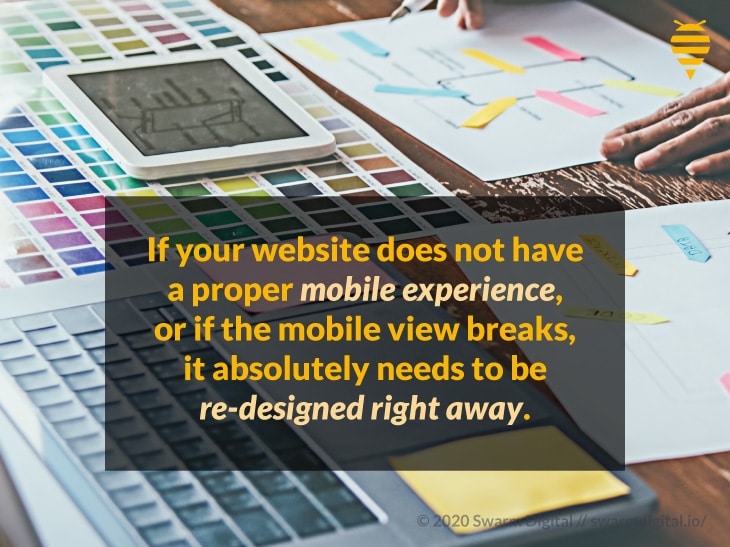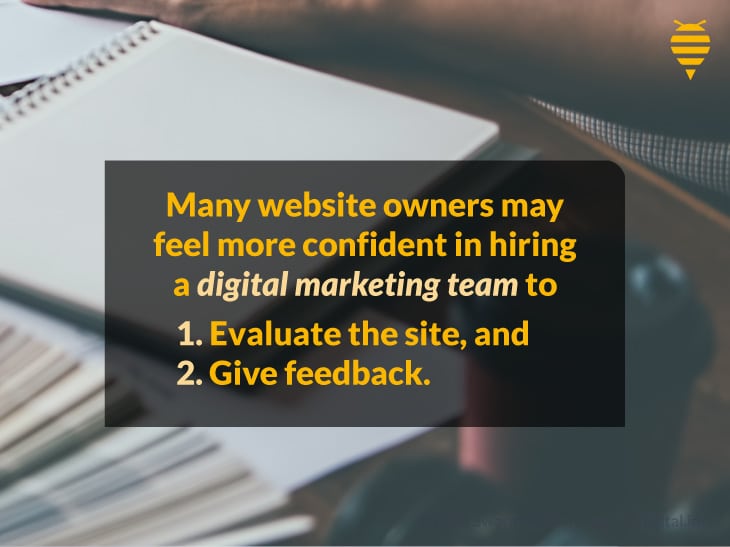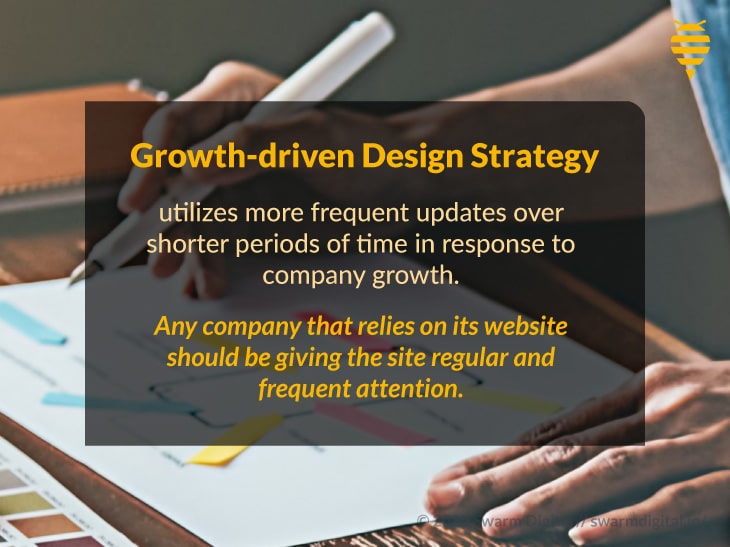How Often Should You Update Your Website’s Design?
- October 8th, 2020
-
Marketing
Web
- David Fugit

Swarm has created this article to assist you in understanding when to update your website. We have included useful industry statistics and covered topics that can help answer your questions. When you are finished reading it, we believe you will be much closer to your answer.
As one of the most effective marketing tools available, websites must capture a company’s brand and identity right away. Consumers often decide whether to trust a brand within the first few seconds of viewing their website. With potential customers at stake, keeping websites up-to-date is critical to the effectiveness of an online brand.
How can you know when your website is due for a refresh? We have included four questions below that may help you pinpoint your website update strategy.
- Why does my site need updating?
- What kind of updates do I need?
- What is my goal in updating my website?
- What are my limitations for updates?
Website updates should be frequent, but the type of updates and frequency will be unique to each company and market sector. Using these questions as guidelines, you can establish a consistent, effective plan for keeping your website up to date.

Why does my website need an update?
In our experience, a re-design is almost always the result of ownership or management being generally unhappy with their website. There are several reasons that they may not like the site, including:
- It looks bad
- It doesn’t feel good or is difficult to use
- It is inaccurate
- It produces customer service issues and complaints
- It does not perform well
For these or any other reasons, management may feel that the entire site needs a refresh. Often, this unhappiness results from too much time going by since the site was last updated. While the business grew, the site aged, and now there is a disconnect between them.
Adding new features to an old website may sound like a quick, easy way to make it current, but it is often better to simply start fresh with a new design. When a website has aged for two to three or even five to 10 years, attempting to add new functionality can waste time and money.
Why websites need to be updated
If your website does not have a proper mobile experience, or if the mobile view breaks, it absolutely needs to be re-designed right away. Mobile users account for a majority of website views in almost every industry. While mobile visitors are critical to a website’s effectiveness, desktop users are more likely to stay longer and you should consider them as well.
Search engines also crawl websites for updates. Frequent updates can improve traffic flow to your website as your information becomes more helpful and relevant to searchers. Google now indexes sites using a practice called “mobile-first.” This means that Google evaluates your website’s mobile experience first.
So if a Google crawler bot hits your site, and this hit results in a broken mobile experience, that can have negative consequences for your site’s SEO performance. Modern websites achieve a seamless experience across various devices and device sizes by utilizing a styling practice called “responsive design.”
Where do I need these updates?
On the flip side, if it’s only been a short time since you have refreshed your site, you may decide that you only need frequent, smaller updates to keep things in good shape. Is the website consistent with branding and company vision, but missing a few key elements? An e-commerce store needs to keep products up-to-date; a news site would need regular updates to include recent stories and trends. Content creators should focus on new and improved content. Each company will have a different area of focus. Figure out why your website needs an update and where these improvements are needed.

What kind of updates do I need?
Once you have established why your website needs an update, you are ready to decide what kind of updating you should do. There are generally two broad categories for website updates.
- Complete overhaul
- Small, consistent updates
Complete overhaul
For a poorly-performing, out-of-date website, starting from scratch is often the most cost-effective choice in the long run. It may initially seem feasible to “just add a few things.” However, newer website features are often not supported on older sites, making a bad situation even worse. Many website owners may feel more confident in hiring a digital marketing team to evaluate the site and give feedback. As experts, a professional team can provide the most effective attack plan towards achieving a current website.
Small, consistent updates
Two common perspectives on when to update a website are:
- Growth-Driven Design (GDD)
- Re-designing every 2-3 years
While keeping the entire website fresh and current is critical to capturing a visitor’s attention right away, a growth-driven design strategy utilizes more frequent updates over shorter periods of time in response to company growth. A photographer’s website would be out of date very quickly if she did not add new content often. For her site to wait for updates for even a few weeks would hurt her website’s impact on potential customers. An e-commerce company would need consistent, perhaps even daily updates to inform customers of new products and sales.
Any company that relies on its website should be giving the site regular and frequent attention. These updates may involve daily or weekly updates, or somewhere in between, depending on the website and company type.

What is my goal in updating my website?
Some questions you may want to ask yourself to determine your goal in updating your website are:
- Are visitors to my site enjoying the user experience?
- Am I getting the performance I want out of my site?
- Does the site accurately represent my brand?
- Is my site secure and functioning correctly?
Answering “no” to any of these questions points to a need your website has for improvement. Determining your goal can help identify areas of focus as you bring your site up-to-date. Unsatisfactory responses to these questions may point to a need for a complete redesign, but that is not always the case.
What can you do to improve the user experience (UX) of your website? Does your navigation need cleaning up? Should the search bar be more obvious? Does it work correctly? There are many ways to improve the UX of a site without a complete redesign. However, suppose the entire site has consistent issues and cannot be quickly improved. In that case, it may be better to redo it completely.
If your site is not performing as you expect or want it to, evaluate what hinders its performance.
You can sometimes improve the security of a site without discarding the entire framework. A professional digital marketing team can help you evaluate your website’s security and whether you should rebuild it.
Regular updates to a site
Some common types of updates that websites may need regularly are:
- The site’s SSL connection is broken
- Broken links and images
- Spelling and grammar issues
- Service description or prices change
- Events and schedules need to update
- On-screen notices
- Sales and promotions
There are many more reasons for updating a website, but this list may help you get started.

What are my limitations for updates?
In a perfect world, companies would have dedicated digital marketing teams whose only job was to evaluate their websites and keep them up to date consistently. Unfortunately, many companies find themselves without the unlimited staff and resources required for this. The good news is that many updates do not require excessive time and money.
If you prepare to invest in a useful, well-functioning website, it is essential not to skimp on the design. A study in 2019 found that the first five seconds of page-load time have the highest impact on conversion rates. There is a steady drop for conversion rates for each additional second of load time. Users often decide whether to trust a website within the first few seconds of viewing it.
Once my site is up to date, what is next?
Whether you opt for a total re-design or smaller updates, keeping your site up to date will require consistent effort. A growth-driven design strategy can save you time and money in the future by making smaller, more frequent updates as your business grows and changes.
If you need assistance with getting an out-of-date website current, a digital marketing team like Swarm is a great resource. We would be happy to work with you to help you reach your goals in updating your website. Please reach out if you feel we can be helpful to you.
